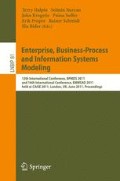Abstract
In this paper, an approach to use task trees in a workflow management system (WfMS) is presented. As hierarchical models task trees capture several hierarchy levels of a workflow in one model. A workflow editor visualizes the models also as flowcharts similar to UML activity diagrams. The WfMS use these models as input and instantiates and executes them. The system is web-based and can be easily accessed by users with any browser clients. This paper motivates the approach to use task trees that produce hierarchical and structured workflow specifications. The proposed language might help end-users to better understand workflow models with its problem oriented hierarchical modeling character. Temporal operators from the task models are compared with certain operators from established workflow languages. In addition, in TTMS an instantiation time concept is implemented, where decision operators are evaluated at the very moment the process is instantiated. Consequently the task tree modeling language is enhanced for modeling decisions in the context of workflow management.
Access this chapter
Tax calculation will be finalised at checkout
Purchases are for personal use only
Preview
Unable to display preview. Download preview PDF.
References
Balzert, H.: Lehrbuch der Software-Technik: Basiskonzepte und Requirements Engineering. Spektrum, Heidelberg (2009)
Brüning, J., Forbrig, P.: Methoden zur adaptiven Anpassung von EPKs an individuelle Anforderungen vor der Abarbeitung. In Geschäftsprozessmanagement mit Ereignisgesteuerten Prozessketten (EPK 2008), Saarbrücken, CEUR-WS, vol. 420 (2008)
Brüning, J., Forbrig, P.: Modellierung von Entscheidungen und Interpretation von Entscheidungsoperatoren in einem WfMS. In: Geschäftsprozessmanagement mit Ereignisgesteuerten Prozessketten (EPK 2009), Berlin, CEUR-WS, vol. 554 (2009)
Brüning, J., Dittmar, A., Forbrig, P., Reichart, D.: Getting SW Engineers on Board: Task Modelling with Activity Diagrams. In: Gulliksen, J., Harning, M.B., van der Veer, G.C., Wesson, J. (eds.) EIS 2007. LNCS, vol. 4940, Springer, Heidelberg (2008)
Dadam, P., Reichert, M.: The ADEPT project: A decade of research and development for robust and flexible process support - challenges and achievements. Computer Science - Research and Development 22, 81–97 (2009)
Diaper, D., Stanton, N.: The Handbook of Task Analysis for Human-Computer Interaction. Lawrence Erlbaum Assoc. Inc., Mahwah (2003)
Eriksson, H.-E., Penker, M.: Business Modeling With UML: Business Patterns at Work. Wiley, Chichester (2000)
Gabriel, M., Ferreira, V., Ferreira, D.R.: Understanding Spaghetti Models with Sequence Clustering for ProM. In: Business Process Management Workshops (BPM 2009 International Workshops), Ulm. LNBIP, vol. 43 (2009)
Hollingsworth, D.: The Workflow Reference Model. Tech. Rep. Document Number TC00-1003, Workflow Management Coalition
Keller, G., Nüttgens, M., Scheer, A.-W.: Semantische Prozessmodellierung auf der Grundlage Ereignisgesteuerter Prozessketten (EPK). In: Veröffentlichungen des Instituts für Wirtschaftsinformatik (IWi), Heft 89, Universität des Saarlandes (January 1992)
Kiepuszewski, B., ter Hofstede, A.H.M., Bussler, C.J.: On structured workflow modelling. In: Wangler, B., Bergman, L.D. (eds.) CAiSE 2000. LNCS, vol. 1789, p. 431. Springer, Heidelberg (2000)
Luyten, K.: Dynamic User Interface Generation for Mobile and Embedded Systems with Model-Based User Interface Development, PhD Thesis in University Limburg (2004)
La Rosa, M., Gottschalk, F., Dumas, M., van der Aalst, W.: Linking Domain Models and Process Models for Reference Model Configuration. In: Proceedings of the International Conference on Business Process Management, BPM 2007 (2007)
Laue, R., Mendling, L.: The Impact of Structuredness on Error Probability of Process Models. In: Information Systems and e-Business Technologies 2nd International United Information Systems Conference UNISCON 2008, Klagenfurt. LNBIP, vol. 5 (2008)
Mori, G., Paterno, F., Santoro, C.: CTTE: Support for Developing and Analyzing Task Models for Interactive System Design. IEEE Transactions on Software Engineering, 797–813 (2002)
Neiger, D., Churilov, L.: Goal-Oriented Decomposition of Event-Driven Process Chains with Value focused Thinking. In: 14th Australasian Conference on Information Systems, Perth
Paterno, F.: Model-Based Design and Evaluation of Interactive Applications. Springer, Heidelberg (2000)
Poluha, R.G.: Application of the SCOR Model in Supply Chain Management. Youngstown, New York (2007)
Rosemann, M., van der Aalst, W.: A configurable reference modelling language. Information Systems 32(1), S.1–S.23 (2007)
Scheer, A.-W.: ARIS: Business Process Modeling. Springer, Heidelberg (1999)
Vanhatalo, J., Völzer, H., Koehler, J.: The refined process structure tree. In: Dumas, M., Reichert, M., Shan, M.-C. (eds.) BPM 2008. LNCS, vol. 5240, pp. 100–115. Springer, Heidelberg (2008)
van der Aalst, W., Pesic, M., Schonenberg, H.: Declarative Workflows Balancing Between Flexibility and Support. Computer Science - Research and Development 23(2), 99–113 (2009)
van der Aalst, W., ter Hofstede, A., Kiepuszewski, B., Barros, A.: Workflow Patterns. Distributed and Parallel Databases 14(3), 5–51 (2003)
van der Aalst, W., ter Hofstede, A.: YAWL – Yet Another Workflow Language (Revised version). QUT Technical Report, FIT-TR-2003-04, Queensland University of Technology, Brisbane (2003)
Weske, M.: Workflow Management Systems: Formal Foundation, Conceptual Design, Implementation Aspects. Habilitation Thesis, University of Münster (2000)
Author information
Authors and Affiliations
Editor information
Editors and Affiliations
Rights and permissions
Copyright information
© 2011 Springer-Verlag Berlin Heidelberg
About this paper
Cite this paper
Brüning, J., Forbrig, P. (2011). TTMS: A Task Tree Based Workflow Management System. In: Halpin, T., et al. Enterprise, Business-Process and Information Systems Modeling. BPMDS EMMSAD 2011 2011. Lecture Notes in Business Information Processing, vol 81. Springer, Berlin, Heidelberg. https://doi.org/10.1007/978-3-642-21759-3_14
Download citation
DOI: https://doi.org/10.1007/978-3-642-21759-3_14
Publisher Name: Springer, Berlin, Heidelberg
Print ISBN: 978-3-642-21758-6
Online ISBN: 978-3-642-21759-3
eBook Packages: Computer ScienceComputer Science (R0)

